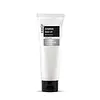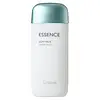What's inside
What's inside
 Key Ingredients
Key Ingredients

 Benefits
Benefits

 Concerns
Concerns

 Ingredients Side-by-side
Ingredients Side-by-side

Water
Skin ConditioningTitanium Dioxide
Cosmetic ColorantAluminum Hydroxide
EmollientStearic Acid
CleansingCyclomethicone
EmollientPEG-10 Dimethicone
Skin ConditioningIsohexadecane
EmollientZinc Oxide
Cosmetic ColorantMethicone
EmollientEthylhexyl Methoxycinnamate
UV AbsorberIsoamyl P-Methoxycinnamate
UV AbsorberCyclopentasiloxane
Emollient4-Methylbenzylidene Camphor
UV AbsorberGlycerin
HumectantCetyl PEG/PPG-10/1 Dimethicone
EmulsifyingDisteardimonium Hectorite
StabilisingIsononyl Isononanoate
EmollientBeeswax
Emulsion StabilisingOzokerite
Emulsion StabilisingSodium Hyaluronate
HumectantAloe Barbadensis Leaf Extract
EmollientCamellia Sinensis Leaf Extract
AntimicrobialCollagen Extract
Skin ConditioningMyrciaria Dubia Fruit Extract
Skin ConditioningMalpighia Emarginata Fruit Extract
Skin ConditioningMagnesium Sulfate
Hydrogenated Lecithin
EmulsifyingLinoleic Acid
CleansingCeramide NP
Skin ConditioningTea-Cocoyl Glutamate
CleansingCaprylic/Capric Triglyceride
MaskingCamellia Japonica Seed Oil
EmollientPhenoxyethanol
PreservativeEthylhexylglycerin
Skin ConditioningParfum
MaskingWater, Titanium Dioxide, Aluminum Hydroxide, Stearic Acid, Cyclomethicone, PEG-10 Dimethicone, Isohexadecane, Zinc Oxide, Methicone, Ethylhexyl Methoxycinnamate, Isoamyl P-Methoxycinnamate, Cyclopentasiloxane, 4-Methylbenzylidene Camphor, Glycerin, Cetyl PEG/PPG-10/1 Dimethicone, Disteardimonium Hectorite, Isononyl Isononanoate, Beeswax, Ozokerite, Sodium Hyaluronate, Aloe Barbadensis Leaf Extract, Camellia Sinensis Leaf Extract, Collagen Extract, Myrciaria Dubia Fruit Extract, Malpighia Emarginata Fruit Extract, Magnesium Sulfate, Hydrogenated Lecithin, Linoleic Acid, Ceramide NP, Tea-Cocoyl Glutamate, Caprylic/Capric Triglyceride, Camellia Japonica Seed Oil, Phenoxyethanol, Ethylhexylglycerin, Parfum
Water
Skin ConditioningButylene Glycol
HumectantAlcohol Denat.
AntimicrobialEthylhexyl Methoxycinnamate
UV AbsorberOctocrylene
UV AbsorberEthylhexyl Salicylate
UV AbsorberButyl Methoxydibenzoylmethane
UV AbsorberHelichrysum Arenarium Extract
AntiseborrhoeicMethyl Methacrylate Crosspolymer
Bis-Ethylhexyloxyphenol Methoxyphenyl Triazine
Skin ConditioningSilica
AbrasiveAlthaea Rosea Root Extract
HumectantCaprylyl Glycol
EmollientGlycerin
HumectantNylon-12
Ethylhexylglycerin
Skin ConditioningParfum
MaskingNelumbo Nucifera Flower Extract
Skin ConditioningPortulaca Oleracea Extract
Skin ConditioningLimonia Acidissima Extract
Skin ConditioningDimethicone
EmollientAcrylates/C10-30 Alkyl Acrylate Crosspolymer
Emulsion Stabilising1,2-Hexanediol
Skin ConditioningBHT
AntioxidantDisodium EDTA
Phenoxyethanol
PreservativeSodium Hydroxide
BufferingRosa Davurica Bud Extract
AntioxidantPotassium Sorbate
PreservativePentylene Glycol
Skin ConditioningChrysanthemum Indicum Flower Extract
Skin ConditioningCamellia Japonica Flower Extract
EmollientVp/Hexadecene Copolymer
Psidium Guajava Leaf Extract
AstringentAbronia Villosa Leaf Extract
Skin ConditioningAloe Barbadensis Leaf Extract
EmollientCinchona Succirubra Bark Extract
Skin ConditioningPrunus Mume Flower Extract
Skin ConditioningCyclopentasiloxane
EmollientSalvia Officinalis Water
Skin ConditioningCalendula Officinalis Flower Water
MaskingPelargonium Graveolens Flower Water
AstringentAcrylates/Dimethicone Copolymer
Skin ConditioningCamellia Sinensis Leaf Extract
AntimicrobialRhodiola Rosea Root Extract
EmollientMorus Alba Fruit Extract
AntioxidantDiospyros Kaki Leaf Extract
Skin ProtectingPueraria Lobata Root Extract
HumectantCinnamomum Cassia Bark Extract
MaskingArtemisia Princeps Leaf Extract
Skin ConditioningMethoxy PEG/PPG-25/4 Dimethicone
EmulsifyingBis-PEG/PPG-20/5 PEG/PPG-20/5 Dimethicone
EmulsifyingCaprylic/Capric Triglyceride
MaskingCaprylyl Methicone
Skin ConditioningBetaine
HumectantWater, Butylene Glycol, Alcohol Denat., Ethylhexyl Methoxycinnamate, Octocrylene, Ethylhexyl Salicylate, Butyl Methoxydibenzoylmethane, Helichrysum Arenarium Extract, Methyl Methacrylate Crosspolymer, Bis-Ethylhexyloxyphenol Methoxyphenyl Triazine, Silica, Althaea Rosea Root Extract, Caprylyl Glycol, Glycerin, Nylon-12, Ethylhexylglycerin, Parfum, Nelumbo Nucifera Flower Extract, Portulaca Oleracea Extract, Limonia Acidissima Extract, Dimethicone, Acrylates/C10-30 Alkyl Acrylate Crosspolymer, 1,2-Hexanediol, BHT, Disodium EDTA, Phenoxyethanol, Sodium Hydroxide, Rosa Davurica Bud Extract, Potassium Sorbate, Pentylene Glycol, Chrysanthemum Indicum Flower Extract, Camellia Japonica Flower Extract, Vp/Hexadecene Copolymer, Psidium Guajava Leaf Extract, Abronia Villosa Leaf Extract, Aloe Barbadensis Leaf Extract, Cinchona Succirubra Bark Extract, Prunus Mume Flower Extract, Cyclopentasiloxane, Salvia Officinalis Water, Calendula Officinalis Flower Water, Pelargonium Graveolens Flower Water, Acrylates/Dimethicone Copolymer, Camellia Sinensis Leaf Extract, Rhodiola Rosea Root Extract, Morus Alba Fruit Extract, Diospyros Kaki Leaf Extract, Pueraria Lobata Root Extract, Cinnamomum Cassia Bark Extract, Artemisia Princeps Leaf Extract, Methoxy PEG/PPG-25/4 Dimethicone, Bis-PEG/PPG-20/5 PEG/PPG-20/5 Dimethicone, Caprylic/Capric Triglyceride, Caprylyl Methicone, Betaine
 Reviews
Reviews

Ingredients Explained
These ingredients are found in both products.
Ingredients higher up in an ingredient list are typically present in a larger amount.
Aloe Barbadensis Leaf Extract is an extract of the leaves of the aloe, Aloe barbadensis, Liliaceae.
Aloe is one of the most well-known natural soothing ingredients, and for good reason. It’s full of water and has a cooling, calming effect on the skin, especially when it’s sunburned, itchy, or irritated. Aloe also helps your skin stay hydrated and smooth by mimicking what healthy skin naturally produces. On top of that, it contains vitamins and nutrients that support skin recovery.
It doesn’t protect you from the sun, but it can help your skin bounce back after too much time in it.
Let’s get into the details:
Aloe contains antioxidant Vitamins A, C, and E, which help fight off free radicals (unstable molecules from things like pollution that can damage your skin).
It’s also rich in polysaccharides, which are natural sugars that help hydrate the skin by acting like the skin’s own moisturizing agents. These, along with other sugars like monosaccharides, help form a protective barrier that locks in moisture.
Aloe works as both a humectant and an emollient. That means it draws water into the skin (humectant) and helps trap it there (emollient), making it an effective natural moisturizer.
You’ll also find a mix of other skin-supporting ingredients in aloe, including folic acid, choline, calcium, amino acids, fatty acids, and even Vitamin B12.
Out of the 420+ species of aloe, Aloe barbadensis is the most widely used in skincare products thanks to its gentle yet effective properties.
There are over 420 species of aloe but Aloe Barbadensis is the most commonly used for topical products.
Learn more about Aloe Barbadensis Leaf ExtractCamellia Sinensis Leaf Extract is derived from the leaves of the tea plant. Black tea, green tea, and oolong tea are all harvested from this plant.
This ingredient has many skin benefits:
This ingredient contains polyphenols, a strong antioxidant. Antioxidants help fight off molecules that damage skin cells.
On top of that, the antioxidants in green tea neutralize free-radicals from the sun. This gives the skin some extra UV protection, but should not replace sunscreen.
Many components of tea have anti-inflammatory properties.
Polyphenols and L-theanine help soothe the skin and reduce irritation. The caffeine in Camellia Sinensis Leaf Extract helps calm inflamed blood vessels.
Other compounds found in tea include: Vitamin Bs, linoleic acid, magnesium, calcium, iron, and zinc.
Research has shown both drinking Camellia Sinensis Leaf Tea and applying it to the skin can help boost skin elasticity and hydration. Studies also show using tea extract may reduce sebum, or oil, production.
Learn more about Camellia Sinensis Leaf ExtractThis ingredient is an emollient, solvent, and texture enhancer. It is considered a skin-softener by helping the skin prevent moisture loss.
It helps thicken a product's formula and makes it easier to spread by dissolving clumping compounds.
Caprylic Triglyceride is made by combining glycerin with coconut oil, forming a clear liquid.
While there is an assumption Caprylic Triglyceride can clog pores due to it being derived from coconut oil, there is no research supporting this.
Learn more about Caprylic/Capric TriglycerideCyclopentasiloxane, or D5, is a silicone used to improve texture of products and trap moisture.
D5 is considered lightweight and volatile. Volatile means it evaporates quickly after application. Once evaporated, D5 leaves a thin barrier that helps keep skin hydrated.
It is also an emollient. Emollients help soften the skin and prevent water loss. Silicones create a silky texture in products. D5 helps other ingredients become more spreadable.
Studies show D5 is safe to use in skincare products. We recommend speaking with a skincare professional if you have concerns.
Learn more about CyclopentasiloxaneEthylhexyl Methoxycinnamate is an organic compound that provides UVB protection. It often goes by the more common name of octinoxate. It is created from methoxycinnamic acid and 2-ethylhexanol.
Ethylhexyl Methoxycinnamate absorbs UVB rays with wavelengths between 280-320 nm. UV absorbers protect your skin by using chemical reactions to convert UV rays into heat and energy.
UVB (290-320 nm) rays emit more energy than UVA rays. They are capable of damaging DNA, causing sunburns and are thought to be linked to skin cancer.
The state of Hawaii has banned sunscreens containing octinoxate due to its potential impact on coral reefs. More research is needed to bridge gaps in this research. The European Union allows higher levels of octinoxate in sunscreens than the US and Australia.
Ethylhexyl Methoxycinnamate is oil soluble. It is not stable and may lose efficacy when exposed to sunlight.
Learn more about Ethylhexyl MethoxycinnamateEthylhexylglycerin (we can't pronounce this either) is commonly used as a preservative and skin softener. It is derived from glyceryl.
You might see Ethylhexylglycerin often paired with other preservatives such as phenoxyethanol. Ethylhexylglycerin has been found to increase the effectiveness of these other preservatives.
Glycerin is already naturally found in your skin. It helps moisturize and protect your skin.
A study from 2016 found glycerin to be more effective as a humectant than AHAs and hyaluronic acid.
As a humectant, it helps the skin stay hydrated by pulling moisture to your skin. The low molecular weight of glycerin allows it to pull moisture into the deeper layers of your skin.
Hydrated skin improves your skin barrier; Your skin barrier helps protect against irritants and bacteria.
Glycerin has also been found to have antimicrobial and antiviral properties. Due to these properties, glycerin is often used in wound and burn treatments.
In cosmetics, glycerin is usually derived from plants such as soybean or palm. However, it can also be sourced from animals, such as tallow or animal fat.
This ingredient is organic, colorless, odorless, and non-toxic.
Glycerin is the name for this ingredient in American English. British English uses Glycerol/Glycerine.
Learn more about GlycerinParfum is a catch-all term for an ingredient or more that is used to give a scent to products.
Also called "fragrance", this ingredient can be a blend of hundreds of chemicals or plant oils. This means every product with "fragrance" or "parfum" in the ingredients list is a different mixture.
For instance, Habanolide is a proprietary trade name for a specific aroma chemical. When used as a fragrance ingredient in cosmetics, most aroma chemicals fall under the broad labeling category of “FRAGRANCE” or “PARFUM” according to EU and US regulations.
The term 'parfum' or 'fragrance' is not regulated in many countries. In many cases, it is up to the brand to define this term.
For instance, many brands choose to label themselves as "fragrance-free" because they are not using synthetic fragrances. However, their products may still contain ingredients such as essential oils that are considered a fragrance by INCI standards.
One example is Calendula flower extract. Calendula is an essential oil that still imparts a scent or 'fragrance'.
Depending on the blend, the ingredients in the mixture can cause allergies and sensitivities on the skin. Some ingredients that are known EU allergens include linalool and citronellol.
Parfum can also be used to mask or cover an unpleasant scent.
The bottom line is: not all fragrances/parfum/ingredients are created equally. If you are worried about fragrances, we recommend taking a closer look at an ingredient. And of course, we always recommend speaking with a professional.
Learn more about ParfumPhenoxyethanol is a preservative that has germicide, antimicrobial, and aromatic properties. Studies show that phenoxyethanol can prevent microbial growth. By itself, it has a scent that is similar to that of a rose.
It's often used in formulations along with Caprylyl Glycol to preserve the shelf life of products.
Water. It's the most common cosmetic ingredient of all. You'll usually see it at the top of ingredient lists, meaning that it makes up the largest part of the product.
So why is it so popular? Water most often acts as a solvent - this means that it helps dissolve other ingredients into the formulation.
You'll also recognize water as that liquid we all need to stay alive. If you see this, drink a glass of water. Stay hydrated!
Learn more about Water